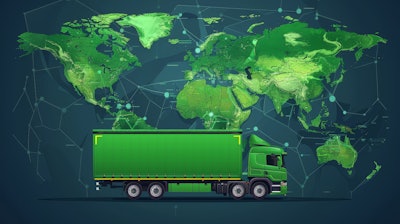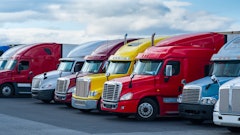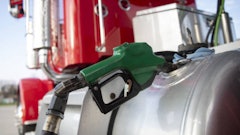
While the start of the year saw consumers opening their wallets in a bid to beat impending tariff-driven price increases, early-year spending—and the associated surge in delivery demand—has cooled. Shippers and their delivery partners are now facing the reality of widespread tariffs, rising costs, and ongoing workforce shortages, straining operational budgets and threatening profitability.
Amidst unpredictable trade measures that are disrupting established trade flows across key freight-linked sectors and limiting long-term visibility for distribution-focused companies, fleet management leaders are also under pressure to meet sustainability targets to satisfy environmental, social and governance (ESG) goals and consumers’ sustainable delivery expectations.
Inextricable link: fleet performance and sustainability
Although the current administration is softening on environmental policies—including a possible rollback or delay by the EPA of the 2027 Clean Trucks Plan aimed at reducing nitrogen oxide (NOx) emissions standards—shippers and delivery companies alike understand that reducing a fleet’s environmental footprint remains an advantageous strategy to optimize fleet performance.
Whether offering eco-friendly delivery options, deploying low-emission vehicles, or implementing route optimization technology, nationwide carriers recognize the synergetic relationship between improving fleet performance and environmental impact and have implemented sustainability action plans aimed at unlocking operational efficiencies and reducing emissions.
Similarly, shippers across multiple industries and fleet sizes—from general wholesale distributors and e-commerce logistics providers to building supply distributors and medical and pharmaceutical lab suppliers—appreciate the bottom-line and customer satisfaction benefits of fleet optimization through a sustainability lens.
A reciprocal (and profitable) relationship
As companies focus on maximizing fleet performance to improve bottom-line health, they must find ways to balance the sustainability of fleet operations with profitability—especially given that 34% of consumers are less willing to pay extra for green delivery due to financial pressures and 37% value convenience and sustainability equally, according to a recent survey.
In good news for fleet operators and delivery companies, the balancing act is not as challenging as it may appear: sustainable fleet management practices and high-performance fleets go hand-in-hand. In fact, fleet management leaders focused on driving greater delivery efficiency and productivity are reaping compelling rewards on both the balance sheet and for the environment. In addition to enjoying reduced costs and plumper margins, they’re delivering the eco-conscious customer experience many consumers want, helping to mitigate churn and drive more consistent revenue flow.
Impact in the field and the coffers
What steps are shippers and delivery companies taking to maximize fleet performance while reducing their environmental impact? With the aim of increasing route efficiency, eliminating manual paper-based processes, and reducing fuel consumption and emissions, many are taking advantage of technology powered by artificial intelligence (AI), such as machine learning (ML), to help meet delivery and profit goals.
How to improve fleet performance
1. Route optimization
By using ML to continuously evaluate tens of thousands of data points and variables in real-time, fleet operators and delivery companies can optimize route planning accuracy and execute more predictable and efficient routes. Fewer stops, reduced fuel consumption, and decreased emissions enhance fleet performance and support sustainability goals.
Even a small distributor with a handful of vehicles can reap significant savings by implementing a route planning and optimization solution. For example, a fleet of three trucks, averaging 120 miles and three hours idling per day per vehicle, can prevent 40 tons of carbon emissions from polluting the environment. Running five days per week at a fuel cost of $3.09 per gallon, this fleet can save an estimated total of $14,313 annually: $5,784 from decreased idling, $5,562 through route optimization, and $2,966 due to improved driver behavior.
Plus, with sophisticated route planning, execution, and dispatch tools, fleet managers can maximize asset use to increase delivery capacity, while reducing the number of vehicles used and lowering vehicle maintenance costs.
2. Last-mile mobile applications
Replacing paper-based delivery documentation (e.g., invoices, bills of lading, delivery receipts) with digital processes not only saves time and money but also helps carriers and distributors eliminate hundreds or even thousands of pieces of paper every day, helping to meet ESG goals and satisfy customer expectations of sustainable practices.
For example, mobile proof-of-delivery (mPOD)—with digital capture of images and signatures via a mobile application—eliminates the time-consuming and error-prone paper trail, enhancing fleet performance through greater delivery efficiency, reducing the number of time-consuming disputes and costly claims, and curbing back-office costs.
3. IoT-based telematics
Individual driver performance has a significant effect on both fleet performance and environmental impact. Excessive idling wastes fuel—a long-haul truck idles about 1,800 hours per year, consuming about 1,500 gallons of diesel—and degrades air quality; aggressive driving causes unnecessary and costly vehicle wear and tear and compromises fleet safety performance.
Leveraging in-cab cameras, telematics solutions offer insights into driver behavior (e.g., speeding, idling, harsh braking) and vehicle performance to minimize excessive idle time, balance asset usage, and correct poor driver performance. IoT-based telematics technology helps commercial fleets reduce fuel costs, emissions, vehicle maintenance, and costly downtime in support of healthy profit margins, sustainability, and optimized delivery performance.
4. GPS-based fleet tracking.
With real-time, end-to-end visibility into vehicle location and status, fleet managers, planners, and dispatchers can easily understand delivery progress and identify and act on exceptions and disruptions to maximize fleet performance. Notably, GPS-based fleet tracking helps reduce vehicle turnaround and idle time at distribution centers and depots, reducing emissions and improving delivery efficiency.
5. Dynamic delivery appointment scheduling.
Optimized scheduling uses ML to evaluate the potential combination of options and constraints to produce a delivery schedule that makes the most effective use of fleet resources. As a result, fleet operators can maximize performance and cut costs by increasing delivery density, resulting greater operational efficiency, less fuel consumed, and a lighter environmental load.
6. Eco-friendly delivery options.
Nearly all (99%) consumers are willing to reduce their environmental impact, with 57% interested in sustainable delivery options, according to a recent study examining home delivery sustainability. Green delivery options, such as carbon-neutral delivery services, combining orders into a single delivery when there are multiple deliveries in an area, or grouping individual shipments into a weekly delivery, are clearly the better choice for the environment. But they also help boost delivery efficiency and productivity while curbing operational expenses to maximize fleet performance and bolster margins.
7. Planned vs. actual performance measurement.
Using AI-powered fleet analytics to fuel data-driven decision-making, fleet managers can measure planned vs. actual fleet performance, establishing a virtuous feedback loop for enhancing delivery, spotting deviations, and ensuring ongoing fleet performance improvement to drive profitability and sustainability.
A fully-optimized fleet is important to profitability and sustainability for shippers and delivery companies alike, especially in the current volatile economic landscape. By leveraging advanced technologies, such as telematics, real-time GPS tracking, and route optimization software, distribution-focused companies can elevate fleet performance in lockstep with environmental sustainability to help protect margins and keep customers happy in these uncertain times.




















